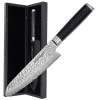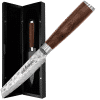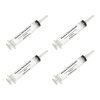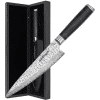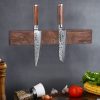Knife sharpening made easy!
Whether filletting knife, paring knife or any other knife, even the high-quality products lose their sharpness over time. To ensure that users can enjoy their high-quality knives for a lifetime, there are a few points that help to maintain their value. These include suitable storage and cleaning by hand and not in the dishwasher. But also the grinding or the correct sharpening plays a particularly important role with the knives, which should not be underestimated in any case. But how exactly can you properly sharpen the knife that is no longer quite so sharp, so that it glides through meat, vegetables and co. with ease?
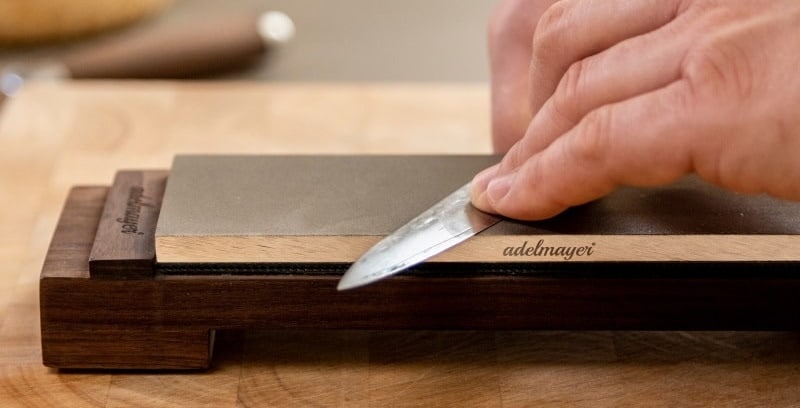
The different ways to sharpen a knife
Of course, it is not easy to resharpen the knife if you do not have the right tool for the job. However, in addition to the right tool, the sharpening itself, as well as its implementation, is an important point to get the individual blades nice and sharp again. In the following, we describe how to get the knives nice and sharp again with a sharpening stone, a sharpening steel and a knife sharpener.
Sharpening knives with the sharpening steel
Sharpening a dull knife is usually no problem with the sharpening steel. This can be used for numerous types of knives or different blades and is also inexpensive to purchase. As a rule, a total of three different sharpening steels are used for sharpening. For example, some models have a chrome-plated and fluted abrasive body. These have the task of straightening up the possibly overturned cutting edge again without grinding off a lot of material. However, if it is a knife that is more blunted, a model with an abrasive body made of ceramic should be used.
These are much harder and can not only straighten the unlaid edge, but at the same time have a higher material removal, which leads to a sharper angle. If it is a sharpening steel with a blade coated with diamonds, an even finer sharpening effect is produced. However, when using it, it is important to maintain an angle of 15 to 20 degrees from the knife blade to the sharpening steel. During the sharpening itself, it is important that the complete cutting edge is guided along the sharpening steel from the base of the handle to the tip of the knife. It does not matter at what speed this process is carried out, so that especially inexperienced or beginners can take their time.
Sharpening the knife with a whetstone
As soon as the desired result can no longer be achieved with a sharpening steel, the whetstone comes into play. This is a particularly effective method of getting dull knives nice and sharp again, so it’s no wonder that they are used not only in private households but also in commercial applications. These have varying degrees of roughness, with which the original cutting edge geometry can be easily restored. The coarse-grained side of the stone is responsible for minor damage to the knife. The fine side, on the other hand, is intended for the final sharpening of the knives. Whetstones are used in conjunction with water. So before you start, it is important that both sides of the stone are soaked with proper water. The sharpening of the knife is started with the coarse side of the stone. This is used to pre-sharpen the blade. There are different ways to drag the knife over the whetstone. A very simple and effective method is to divide the knife into several parts to make sharpening even easier.
It is also essential to always sharpen the blade at the correct angle, which is 15 degrees for European knives. If it is a Japanese blade, the angle should be 10 degrees. If you feel unsure about this, you can use two 1-euro coins to set the angle. Again, the speed does not matter when grinding the knife. Begin sharpening with the whetstone, with the tip of the knife. Now the knife is pulled over the stone with an even pressure and keeping the angle. It is important to sharpen the other parts of the blade in flowing movements. The sharpening of the knife should be finished only when a uniform degree can be observed on the blade. After the other side of the blade has also been sharpened with the coarse whetstone side, continue with the fine whetstone side. Sharpening on the fine-grained side works the same way. The process is finished when no more grade can be felt on either side.
Sharpening the knife with the knife sharpener
Of course, a knife can only ever cut as well as the sharpness of its blade makes it possible. Especially for private use, knife sharpeners are a welcome utensil to get the dull knives nice and sharp again. This is a particularly simple method that can be used even by beginners. Sharpening with a knife sharpener is not only particularly simple, but also very safe, unlike other methods. The different models are suitable for different types of knives, so that both the European and Japanese blades can be made nice and sharp again.
It is important that the knives to be sharpened are nice and clean and dry at the same time. And you’re ready to go. For sharpening, the knife or the knife blade is pulled through the specified opening of the knife sharpener. With a slight pressure, but not too hard, this process is repeated until the knife is nice and sharp again. By the way, with most knife sharpeners it is possible to use different material for sharpening. So it is suitable for very dull knives as well as for models which simply need to be re-sharpened briefly.
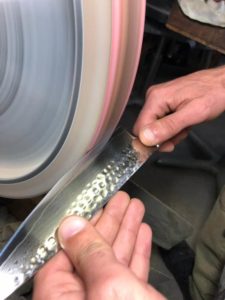
Conclusion
Depending on how skilled and practiced one is, the knives can be made nice and sharp again in different ways. Experts even advise to sharpen the different knives regularly as soon as they are used intensively. With a little practice, the applications with the sharpening steel or the sharpening stone also work without problems. But also the knife sharpener makes it possible that in the private kitchen the knives can be re-sharpened if necessary and thus glide smoothly through meat, vegetables and fruit.

